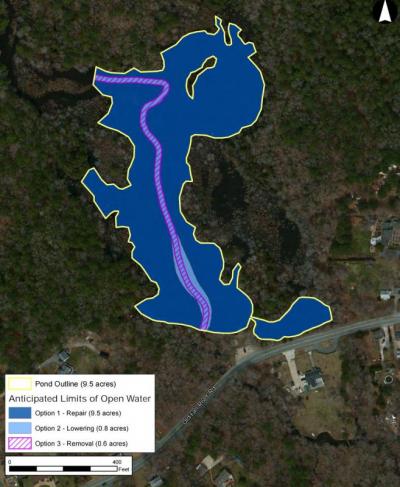Officials: dam to be a costly fix, requires more research
Located in North Dartmouth along the Copicut River, the deteriorating Cornell Pond Dam poses a threat to properties downstream, but fixing it could require the town to pay upwards of $1.1 million and deal with contaminated sediments at the site.
The state Department of Conservation and Recreation has mandated that the dam, which was constructed in 1935 but dates as far back as 1799, be repaired by September 2018. Structural issues include deteriorating concrete and stone masonry, spillways, and embankments. Select Board members on Monday heard possible solutions and expected hurdles for the project.
"If the dam were to burst on its own, which can happen in a 100-year flood, it could cause damage downstream," said Environmental Affairs Coordinator Michael O'Reilly.
Most of the land surrounding Cornell Pond is owned by the Rod & Gun Club of New Bedford, the Dartmouth Natural Resources Trust, and the town.
Any fixes would disturb the "exceedances of PCBs, lead, and zinc" found on the pond floor, according to a 2015 inspection and evaluation report completed on the dam.
PCBs — or polychlorinated biphenyl — are industrial chemicals that were banned in 1979 due to impacts on human and environmental health, according to the National Oceanic and Atmospheric Administration. According to officials, the PCB contamination in Cornell Pond is leftover from the Resolve, Inc. Superfund Site, which used to be located in the area.
Officials are currently looking at three options to fix the liability. Repairing the dam is estimated to cost $1,086,102. Alternatively, lowering the dam could cost about $853,081, and breaching the dam could cost about $816,425.
O'Reilly added that breeching the dam would be a staged process that would take three to five years to complete.
Additionally, lowering or breaching the dam would change the pond's appearance and consequentially expose the contaminated sediments at the bottom. Repairing the dam would preserve the total 9.5 acres of open water, while lowering or breaching would turn the pond into a small stream, with .8 and .6 acres of open water respectively, according to the report.
"Breaching is the cheapest way out, but is it really — aesthetically and characteristic of the town — the best way out?" asked Selectman Shawn McDonald. "I'd hate to see such a nice-looking site become just a river."
Cornell Dam Advisory Committee member Tom Yena agreed.
"You're going to make a swampy mess if we do that," he said.
The Select Board created the advisory committee last June to research the outlined issues.
Committee member Bill Chandler said he hopes that money from the federal government would be available for the project, despite the Trump administration's slashing of conservation funding. However, O'Reilly said that while grants exist for lowering and breaching dams, he is unaware of any that could help fund the repairs.
O'Reilly said the committee is starting to research a fourth option, although cost estimates are not yet available. He suggested breaching the dam and excavating the sediment, but costs would depend on the extent of the contamination. He guessed the option is a $2-3 million project.
"If I could get the [Environmental Protection Agency] involved... it's very preliminary, but I'm hopeful we could offset some of that cost," he said.
O'Reilly said that, while there are few invasive species surrounding the pond, vegetation would require monitoring following the fixes.
Chandler said concerns of abutters would be taken into account during the decision-making process.















